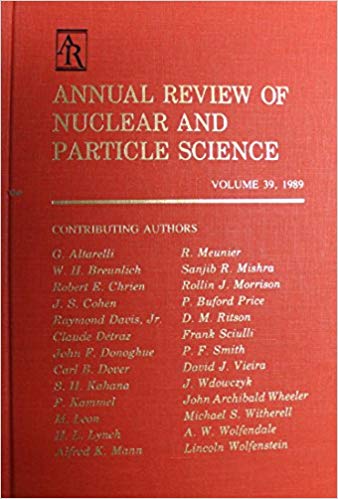定向后坐力检测
IF 8.4
2区 物理与天体物理
Q1 PHYSICS, NUCLEAR
Annual Review of Nuclear and Particle Science
Pub Date : 2021-02-09
DOI:10.1146/annurev-nucl-020821-035016
引用次数: 39
摘要
在过去的几年里,对暗物质引起的反冲的研究取得了令人印象深刻的进展。然而,该领域面临着几个突出的问题。首先,不可避免的太阳中微子背景将很快抑制许多暗物质模型的结论性鉴定。其次,更根本的是,目前的实验没有切实可行的方法来确认探测到的信号来自银河系。定向探测的概念解决了这两个问题,同时为研究新的暗物质和中微子相关物理学提供了机会。这个概念在实验上仍然具有挑战性,但气体时间投影室是一个越来越有吸引力的选择,如果配置得当,可以同时测量原子核和电子的反冲。在这篇综述中,我们重新评估所需的探测器性能和调查相关技术。幸运的是,实现良好方向性所需的高度分段检测器也可以进行一些基础和应用物理测量。我们将对近期的挑战以及该领域如何取得进展发表评论。预计《核与粒子科学年鉴》71卷的最终在线出版日期为2021年9月。修订后的估计数请参阅http://www.annualreviews.org/page/journal/pubdates。本文章由计算机程序翻译,如有差异,请以英文原文为准。
Directional Recoil Detection
Searches for dark matter–induced recoils have made impressive advances in the last few years. Yet the field is confronted by several outstanding problems. First, the inevitable background of solar neutrinos will soon inhibit the conclusive identification of many dark matter models. Second, and more fundamentally, current experiments have no practical way of confirming a detected signal's Galactic origin. The concept of directional detection addresses both of these issues while offering opportunities to study novel dark matter– and neutrino-related physics. The concept remains experimentally challenging, but gas time projection chambers are an increasingly attractive option and, when properly configured, would allow directional measurements of both nuclear and electron recoils. In this review, we reassess the required detector performance and survey relevant technologies. Fortuitously, the highly segmented detectors required to achieve good directionality also enable several fundamental and applied physics measurements. We comment on near-term challenges and how the field could be advanced. Expected final online publication date for the Annual Review of Nuclear and Particle Science, Volume 71 is September 2021. Please see http://www.annualreviews.org/page/journal/pubdates for revised estimates.
求助全文
通过发布文献求助,成功后即可免费获取论文全文。
去求助
来源期刊
CiteScore
21.50
自引率
0.80%
发文量
18
期刊介绍:
The Annual Review of Nuclear and Particle Science is a publication that has been available since 1952. It focuses on various aspects of nuclear and particle science, including both theoretical and experimental developments. The journal covers topics such as nuclear structure, heavy ion interactions, oscillations observed in solar and atmospheric neutrinos, the physics of heavy quarks, the impact of particle and nuclear physics on astroparticle physics, and recent advancements in accelerator design and instrumentation.
One significant recent change in the journal is the conversion of its current volume from gated to open access. This conversion was made possible through Annual Reviews' Subscribe to Open program. As a result, all articles published in the current volume are now freely available to the public under a CC BY license. This change allows for greater accessibility and dissemination of research in the field of nuclear and particle science.

 求助内容:
求助内容: 应助结果提醒方式:
应助结果提醒方式:


